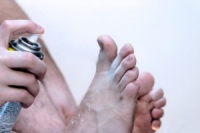The condition that is referred to as athlete’s foot is known to be a contagious fungal infection. It may typically occur as a result of fungus entering the feet through tiny cracks in the skin. A perfect environment for this type of fungus to thrive in are warm and moist areas, which may include the inside of shoes and socks. It most commonly affects the space between the toes, and noticeable symptoms may include severe itching and redness, in addition to the skin becoming cracked, which may be painful. It is typically spread by walking barefoot in public pools and surrounding areas, including locker rooms and shower stalls. There may be some patients who have specific medical conditions that may encourage athlete’s foot to develop easier. These may include poor blood circulation, dermatitis, or a genetic trait. If you have any of the symptoms that are associated with athlete’s foot, it is advised to speak to a podiatrist who can properly assist you in choosing the correct treatment.
Athlete’s foot is an inconvenient condition that can be easily reduced with the proper treatment. If you have any concerns about your feet and ankles, contact Dr. Kenneth Donovan from Advanced Care Foot and Ankle.
Our doctor will treat your foot and ankle needs.
Athlete’s Foot: The Sole Story
Athlete's foot, also known as tinea pedis, can be an extremely contagious foot infection. It is commonly contracted in public changing areas and bathrooms, dormitory style living quarters, around locker rooms and public swimming pools, or anywhere your feet often come into contact with other people.
Solutions to Combat Athlete’s Foot
- Hydrate your feet by using lotion
- Exfoliate
- Buff off nails
- Use of anti-fungal products
- Examine your feet and visit your doctor if any suspicious blisters or cuts develop
Athlete’s foot can cause many irritating symptoms such as dry and flaking skin, itching, and redness. Some more severe symptoms can include bleeding and cracked skin, intense itching and burning, and even pain when walking. In the worst cases, Athlete’s foot can cause blistering as well. Speak to your podiatrist for a better understanding of the different causes of Athlete’s foot, as well as help in determining which treatment options are best for you.
If you have any questions please feel free to contact one of our offices located in Warren, Livingston, and Toms River, NJ . We offer the newest diagnostic and treatment technologies for all your foot and ankle needs.

